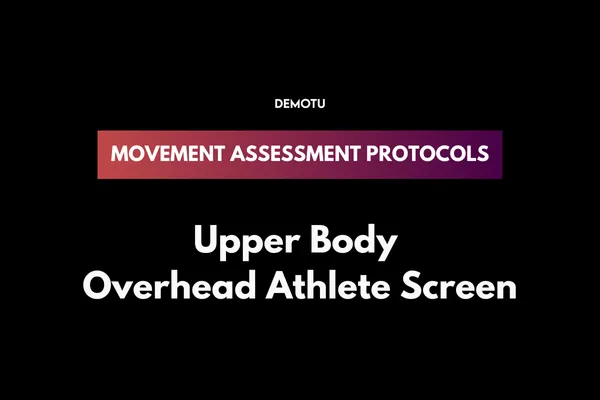
Upper Body Overhead Athlete Screen: A Comprehensive Guide for Athletic Trainers
Movement Analysis, Workout Builder
For overhead athletes such as baseball pitchers, volleyball players, and tennis players, shoulder mobility and stability are critical to both performance and injury prevention. Athletic Trainers play a pivotal role in identifying mobility limitations and strength imbalances in the upper body that may predispose these athletes to injury. Demotu’s Upper Body Overhead Athlete Screen provides a fast, accurate, and reliable way to evaluate shoulder function without relying on frustrating AI systems.
By using our research-based movement protocols, Athletic Trainers can avoid the inconsistencies of AI motion capture, gaining a more detailed and precise understanding of each athlete’s strengths and weaknesses. Here is our comprehensive Upper Body Overhead Athlete Screen, designed to help you assess shoulder mobility and stability, as well as overall movement quality.
Upper Body Overhead Athlete Screen Protocol
Functional Assessments
1. Push
Focus: Shoulder mobility
This test involves the athlete performing a basic push-up movement while maintaining proper form. The focus is on shoulder mobility and how well the athlete can stabilize their shoulders under load. Pay close attention to any asymmetry between the two shoulders, which can indicate a mobility issue or strength imbalance.
2. Overhead Squat
Focus: Global shoulder and thoracic mobility
The overhead squat is a powerful screening tool for assessing both shoulder mobility and thoracic spine extension. Instruct the athlete to perform a squat while holding their arms overhead. This movement requires stability and control in the shoulders, as well as good thoracic mobility. Look for any compensations, such as leaning forward or arms dropping, which can suggest restrictions in shoulder or thoracic mobility.
Joint Comparisons
Shoulder Abduction: Assess the athlete’s ability to lift their arm away from the body, noting any restrictions in range or pain during the movement.
Shoulder Flexion: Measure the athlete’s capacity to raise their arm in front of them. Limited shoulder flexion can lead to improper mechanics in overhead movements, increasing injury risk.
Shoulder Internal/External Rotation: Compare the range of internal and external rotation in each shoulder. Imbalances in these movements are common in overhead athletes and are often linked to shoulder injuries like rotator cuff tears.
Cervical Rotation: The ability to rotate the neck without compensating through the shoulders is essential for proper upper body alignment and function. Restricted cervical rotation can impact overhead athletes, particularly those involved in sports requiring rotational movement like tennis or baseball.
Research & Insights
Research shows that shoulder range of motion (ROM) and strength imbalances are major predictors of injury in overhead athletes. By identifying these issues early through movement analysis, Athletic Trainers can help athletes correct them before they lead to shoulder impingement, rotator cuff injuries, or even more serious conditions like labral tears.
Why Choose Demotu’s Protocols Over Having AI Force Your Results?
At Demotu, we provide highly accurate movement screenings without the need for AI-based motion capture. While AI has its place, it often lacks the fine-tuned precision that Athletic Trainers need when assessing complex movements like overhead squats and shoulder stability exercises. Our protocols are designed to deliver consistent and reliable results, ensuring that your athletes receive the best care possible.
Using Demotu’s Upper Body Overhead Athlete Screen, you can quickly identify limitations in shoulder mobility, cervical rotation, and overall upper body function. Our advanced protocols, which do not rely on AI, give you a clearer, more accurate picture of your athlete's movement patterns, helping you tailor corrective exercises that address their specific needs.
Corrective Exercises and Workout Builder
Our platform also includes a workout builder and exercise builder, making it easy to develop custom routines to strengthen the shoulders and improve mobility. Whether you're addressing shoulder abduction, enhancing internal rotation, or improving cervical rotation, Demotu’s tools provide a seamless way to implement shoulder-specific exercises.
Learn our Adaptive Functional Functional Movement Screen 👉
By including exercises that focus on areas like shoulder flexion and external rotation, Athletic Trainers can correct imbalances and reduce the risk of injury in their athletes. Early identification of these issues, paired with targeted workouts, is the key to enhancing both performance and longevity for overhead athletes.
Click Here To Use Motion Capture for Movement Assessments - Free Today!